William Baker of Audlem
| William Baker | |
|---|---|
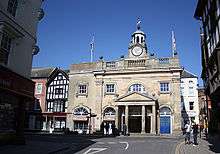 The Buttercross, Broad Street, Ludlow 1743-4 | |
| Born |
1705 London |
| Died |
1771 Audlem, Cheshire |
| Nationality | British |
| Alma mater | Possibly a pupil of Francis Smith of Warwick |
| Occupation | Architect |
| Buildings | Montgomery Town Hall, The Buttermarket Ludlow, |
William Baker of Audlem (1705–1771) was an architect, surveyor and building contractor, working in Shropshire and the adjacent counties in the middle years of the 18th Century.[1][2]
Early life
He was the son of Richard Baker, who had moved from London to Ludlow. In 1737 he married Jane Dod of Audlem and for a time lived at Bridgnorth. In the 1740s his wife inherited Highfields House and they moved to Audlem.
Career
Baker was employed by the noted architect Francis Smith of Warwick in the 1730s. His account book for the years 1748–59 survives, which provides information about his architectural and surveying practice.[3] The house in which he lived at Highfields was the subject of an article in Country Life, where a portrait of the architect survives.[4]
Architectural Work
Baker was well grounded in the fashionable architecture of the early 18th Century, having first worked for Francis Smith of Warwick. He is mentioned as working as a carpenter for Smith at Ditchley in Oxfordshire in 1727.[3] He set up his own practice around 1740 and also acted as a building contractor and surveyor. Initially he developed the practice in eastern Shropshire and Staffordshire and continued to work for many of clients of Francis Smith after Smith’s death in 1738. Houses by Smith which Baker continued to work on included Mawley Hall in Shropshire, Swynerton Hall in Derbyshire and Wingerworth Hall in Derbyshire. He always had a close relationship with the innovative Shrewsbury architect Thomas Farnolls Pritchard.[5] In 1743 at Ludlow, both Prichard and Baker put forward plans for the Buttercross, but it was Baker who was selected to do the work. In 1746 Baker was paid for the plans and work at the Royal Shrewsbury Infirmary, but the plans are signed by Thomas Farnolls Pritchard. It is likely that Pritchard was working under Baker on this project. Again for the building of St John’s Church, Wolverhampton it is likely that Pritchard was the supervising architect working under Baker. In 1775-5, after Baker’s death, Pritchard continued Baker’s survey work at Powis Castle.[6]
The Ludlow Buttercross and Henry Arthur Herbert
Most notably Baker gained the patronage of Henry Arthur Herbert (1703–72), who became Earl of Powis in 1748[7][8]

Baker would have known Henry Herbert from his Ludlow connections. Herbert was the Whig Member of Parliament and a member of Ludlow Town Council when Baker was awarded the contract to build the Ludlow Buttercross. Also in 1743 Henry Herbert relinquished his position as Member of Parliament when he inherited Powis Castle and became Lord Herbert of Chirbury. In 1735 he had been appointed Custos Rotulorum of Montgomeryshire and Lord-Lieutenant of Shropshire. and this now provided him with a power base to dispense patronage in both Montgomeryshire and Shropshire. Baker’s design of the Buttercross (which housed the Ludlow Council Chamber) is based on James Gibbs "A Book of Architecture" (1728). Clearly the Buttercross impressed him.
Between 1748 and 1758 he got Baker to alter his house at Oakly Park at Bromfield, just outside Ludlow. Then, between 1748-54 Baker undertook repairs at Powis Castle, possibly in preparation for Herbert to move into the castle. Also in 1748, Herbert got William Baker to design and build the Town Hall at Montgomery.[9] The new Town Hall was intended to accommodate the Court of Great Sessions when it met at Montgomery and over which Herbert presided as Custos Rotulorum. At Bishops Castle Baker submitted designs for a new Town Hall to Herbert in 1745, but it was slightly later that the Town Hall was built and to modified designs.
Richard Baker
His son Richard Baker (1743–1803), continued the practice after his father’s death in 1771. Richard seems to have practised mainly as a building surveyor, and there are few buildings that he designed.[10]
List of architectural works
Public building and monuments

- Bishops Castle, Shropshire. Town Hall 1745-50[11][12]
- Ludlow, Shropshire, The Butter Cross 1743-4. The design is derived from James Gibb's 'Book of Architecture', 1728. Faced with Grinshill stone with a low pedimented portico and a semi-circular or lunette window above. The parapet has heavy balustrading, capped with ball pinnacles.[13][14]
- Shrewsbury. Royal Shropshire Infirmary 1747. The plans are signed by Thomas Farnolls Pritchard, but Baker was commissioned and paid for the work.[15]
- Montgomery, The Town Hall 1748 -51,[11][16][17]
- Hereford, College of the Vicars Choral.1750. Repairs and alterations [11]
Churches

- St Peter's Church, Congleton, Cheshire. A church here since the 15th century (The Higher Chapel). The present church was built by William Baker in 1740-1742 for £2,000.[18]
- Stone, Staffordshire, Gothic revival 1754-8 designed by William Robinson, Clerk to the Board of Works, who produced the first designs for Strawberry Hill for Horace Walpole[19]
- St John's Church, Wolverhampton, 1756-9. A very grand ashlar faced church which is based on James Gibbs' St Martin-in-the-Fields, London. Built as a Chapel of St Peter’s Collegiate Church, Wolverhampton by a private Act of Parliament in 1755. There is some uncertainty as to whom the architect was, but there is no doubt that the main contractor was William Baker, who was helped by the local builder and architect, Roger Eykyn. Traditionally the design of the church has been credited to the Shrewsbury architect Thomas Farnolls Pritchard, but it could be that he supervised the construction for Baker.[20][21]
- Seighford, Staffordshire. Tower and Nave rebuilt. Metal framed gothic windows. Brick pilasters with ?mock artillery slits, which also appear on the crenellations of the tower; which is surmounted by four corner pinnacles. Looks like a very early attempt to re-create German Brick Gothic[21]
%2C_Cheshire.jpg)
- Ellenhall, Staffordshire 1757. £1023 estimated for the repair of the Church.[21]
- St Mary's Church, Acton, near Nantwich, Cheshire. Upper part of the tower was blown into Nave, March 1757. Sandstone. The church must have been extensively re-built and the Medieval entrance has been altered and embellished. Remarkable ornamented west gable to Chancel. Ornamentation to tower below parapet, which has ‘gun slits’ in the crenulations (cf Seigford). Four crocketed corner pinnacles with lower mid-ball pinnacles on tower. Sundial surmounted with Baker’s typical ball pinnacle.[21]
- St Chad's Church, Wybunbury, Cheshire.[21] Tower leaning as the result of subsidence. Baker appears to have solved the problem, but the Nave and Chancel had to be demolished in 1970.
- Plans for a Kirk in Gothic style at Kenmore Perthshire 1760.[21]
- Upper Penn church, nr Wolverhampton.1765. Baker cased the tower in brickwork. Crenulations to the parapet of tower with four crocketed corner pinnacles. Ornamented gothic tower window.
Houses
Most of these are recorded architectural drawings and surveys, and it is not clear to what extent Baker’s work was carried out.
- Ludlow 52 Broad Street[11]
- Wolverhampton Penn Hall[11]
- North Claines, Worcestershire. Bevere House 1748-9[11]
- Morville Hall, Shropshire. Addition of two wings.[11]
- Liverpool. Houses in Hanover Street.1748. Demolished.[11]
- Mawley Hall, Shropshire. Possible work to stables 1748.[11]
- Ranton Abbey Staffordshire. Surveyed 1748-1742. Gutted c1940.[11]
- Powis Castle Montgomeryshire Unspecified work 1748-54[11]
- Bromfield Oakley Park, alterations 1748-58[11]

- Enville Staffordshire,"Lady Dorothy's Cottage" For the Earl of Stamford 1748-50[11][22]
- Morville, Aldenham House, Shropshire. Stable Block 1750-1[11][23][24]
- Tixall Hall Staffordshire. 1750-1. Demolished c1925.[11]
- Darlaston Hall, Staffordshire. Plans for a house. Demolished 1953.[11]
- Acton Burnell Hall, Shropshire 1753-8[11]
- Wood Eaton, Staffordshire The Hall Farmhouse. 1753-6.[11]
- Wingerworth Hall, Derbyshire. Work undertaken 1753-4. Demolished c.1930.[11]
- Stoke on Tern, Shropshire, Woodhouse Farm, 1754-8. An example of Baker's smaller brick houses, with central chimney stack. Each face of the house has a forward central bay, with doorway with a castellated or crenelated, pediment or parapet.[25]<ref`>Mercer E "English Architecture to 1900: The Shropshire Experience" Logaston Press, 2003.201</ref>
- Swynnerton Hall, Staffordshire. Outbuildings. 1754.[11]
- Patshull House, Staffordshire.1754-8. Baker completed the work of James Gibbs, who died in 1754. This included the flanking pavilions, and forecourt, with gateway and stables.[26]
- Hankelow Hall, Cheshire Alterations. 1755-7.[11]
- Egginton Hall, Derbyshire. Alterations. 1755-7.[11]
- Terrick Hall, Whitchurch. Plan 1756.[11]
- Whitmore Hall, Staffordshire. Survey 1765.[11]
- Brand Hall, Norton in Hales, Shropshire 1756. Minor Alterations.[11]
- Hanmer Hall, Wrexham. Additional building. 1756.[11]
- Astbury Rectory, Cheshire. Alterations 1757-9. Typical ball pinnacles on parapet.[11]
- Keele Hall, Staffordshire. Alterations 1757-9.[11]
- Dorfold Hall, Cheshire. Alterations 1757-9.[11]
- Woodhouse or Wodehouse nr Wombourne, Staffordshire. Stable block. 1758-9.[11]
- Sidway Hall near Maer, Staffordshire. Altered or rebuilt 1758-9.[11]
- Teddesley Hall, Penkridge, Staffordshire. Possible wings, c1759, demolished 1954.[11]
Houses attributed on stylistic grounds.
- Burnhill Green Farm Patshull[22]
- Woore The Swan Hotel[22]
- Sibdon Carwood, Shropshire. Sibdon Castle,[22]
Gallery of architectural work
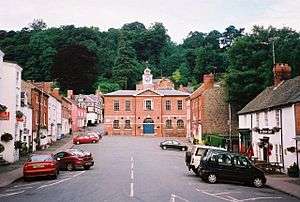 Montgomery Town Hall - William Baker, Architect, altered by Thomas Penson
Montgomery Town Hall - William Baker, Architect, altered by Thomas Penson Bishops Castle Town Hall, Probably by William Baker c1745-50.
Bishops Castle Town Hall, Probably by William Baker c1745-50.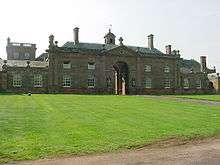 Patshull Hall - Burnhill Green, Nr Pattingham. Gateway by William Baker after 1754
Patshull Hall - Burnhill Green, Nr Pattingham. Gateway by William Baker after 1754 Whitmore Hall. Surveyed by Baker 1765.
Whitmore Hall. Surveyed by Baker 1765. The Tower of Saint Bartholomew's Church, Upper Penn, rebuilt by William Barker in1765
The Tower of Saint Bartholomew's Church, Upper Penn, rebuilt by William Barker in1765 The Church of Saint Bartholomew, Upper Penn, Staffordshire. Tower rebuilt by William Barker in1765
The Church of Saint Bartholomew, Upper Penn, Staffordshire. Tower rebuilt by William Barker in1765 St Peter's Church Congleton
St Peter's Church Congleton St Michael's Church, Stone
St Michael's Church, Stone Stone - Church
Stone - Church The Church of St. John in the Square, Wolverhampton
The Church of St. John in the Square, Wolverhampton Church of St John, Wolverhampton
Church of St John, Wolverhampton St. John's Church, Wolverhampton
St. John's Church, Wolverhampton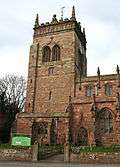 St Marys Acton Cheshire tower
St Marys Acton Cheshire tower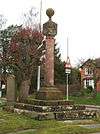 Sundial Acton churchyard
Sundial Acton churchyard%2C_Cheshire.jpg) Acton church (west view), Cheshire
Acton church (west view), Cheshire St Marys Acton Cheshire door
St Marys Acton Cheshire door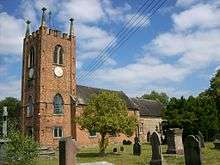 St Chad, Seighford
St Chad, Seighford Wybunbury, Tower of St. Chad's Church
Wybunbury, Tower of St. Chad's Church
References
- ↑ Colvin H. A Biographical Dictionary of British Architects 1600-1840 Yale University Press, 3rd edition London, 1995, 93. The 4th edition, published in 2008 may contain further information.
- ↑ A Oswald "William Barker of Audlem, Architect" in Collections for a History of Staffordshire (Staffordshire Record Society)(1954), 1950-1.
- 1 2 R.Morrice ‘The Payment Book of William Baker of Audlem’, in "English Architecture Public and Private: Essays for Kerry Downes" ed Bold & Cheney,1993.
- ↑ J.M. Robinson, "Highfields, Audlem, Cheshire" Country Life, 31 January 1991
- ↑ Ionides J. "Thomas Farnolls Pritchard of Shrewsbury, Architect and ‘Inventor of Cast Iron Bridges’". The Dog Rose Press, Ludlow 1999, 31-34
- ↑ “Colvin” 784
- ↑ Henry Arthur Herbert was the 1st Earl of Powis of the 2nd creation and between 1743 and 1748 was Lord Herbert of Chirbury. He was the son of Francis Herbert of Oakley Park. Oakly Park was his main country home until 1771, when he sold it to Lord Clive ('Clive of India') and moved into Powis Castle. The National Trust. "Powis Castle" guidebook. 1996. p. 58.
- ↑ J. Smith "Herbert Correspondence", Univ. Wales Press 1963, 2-5.
- ↑ J D K Lloyd, ‘Montgomery Town Hall and its Architect’ Montgomeryshire Collections, 1958, 128-132
- ↑ "Colvin" 93. A building for which he may be responsible is Clun Town Hall, built for the Earl of Powys in 1780, with all the characteristics of his father’s work, but completed after his father’s death
- 1 2 3 4 5 6 7 8 9 10 11 12 13 14 15 16 17 18 19 20 21 22 23 24 25 26 27 28 29 30 31 32 "Colvin" 3rd edition, 94-5
- ↑ J Newman and N Pevsner "The Buildings of England: Shropshire", Yale 2006.152
- ↑ "Newman and Pevsner" , 373 and pl.373
- ↑ Ionides J. "Thomas Farnolls Pritchard of Shrewsbury, Architect and ‘Inventor of Cast Iron Bridges’". The Dog Rose Press, Ludlow 1999, 60.
- ↑ "Ionides" 31-2
- ↑ R Scourfield and R Haslam "The Buildings of Wales: Powys; Montgomeryshire, Radnorshire and Breconshire" Yale University Press 2013, 210
- ↑ "Lloyd", 128-132
- ↑ This information is taken from the Wikipedia Commons entry and on the basis of the stylistic appearance, it looks correct
- ↑ "Colvin" 95 & 831
- ↑ Ionides J. "Thomas Farnolls Pritchard of Shrewsbury, Architect and ‘Inventor of Cast Iron Bridges’'. The Dog Rose Press, Ludlow 1999, 282.
- 1 2 3 4 5 6 "Colvin" 3rd edition, 95
- 1 2 3 4 "Morrice"
- ↑ Country Life, 30 June
- ↑ J Newman and N Pevsner "The Buildings of England: Shropshire", Yale 2006, 112
- ↑ J Newman and N Pevsner "The Buildings of England: Shropshire", Yale 2006, 607
- ↑ Victoria County History of Staffordshire, Vol 20, 165-7
Literature
- Colvin H. A Biographical Dictionary of British Architects 1600-1840 Yale University Press, 4th edition London, 2008.
- Ionides J. "Thomas Farnolls Pritchard of Shrewsbury, Architect and ‘Inventor of Cast Iron Bridges’". The Dog Rose Press, Ludlow 1999
- Mercer E "English Architecture to 1900: The Shropshire Experience" Logaston Press, 2003.
- R.Morrice ‘The Payment Book of William Baker of Audlem’, in "English Architecture Public and Private: Essays for Kerry Downes" ed Bold & Cheney,1993.
- Reid P "Burke’s and Savills Guide to Country Houses, Vol II, Herefordshire, Shropshire, Warwickshire, Worcestershire" London, 1980, 104-5
- J Newman and N Pevsner "The Buildings of England: Shropshire", Yale 2006.
- J M Robinson "A Guide to the Country Houses of the North-West" Constable, 1991.
External links
| Wikimedia Commons has media related to William Baker of Audlem. |